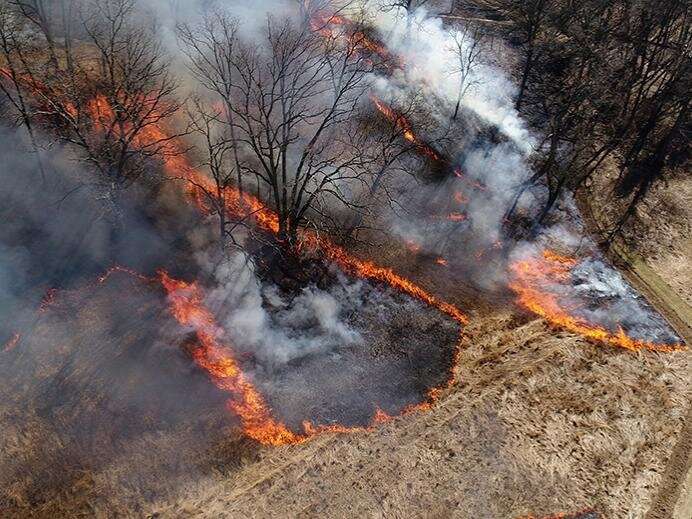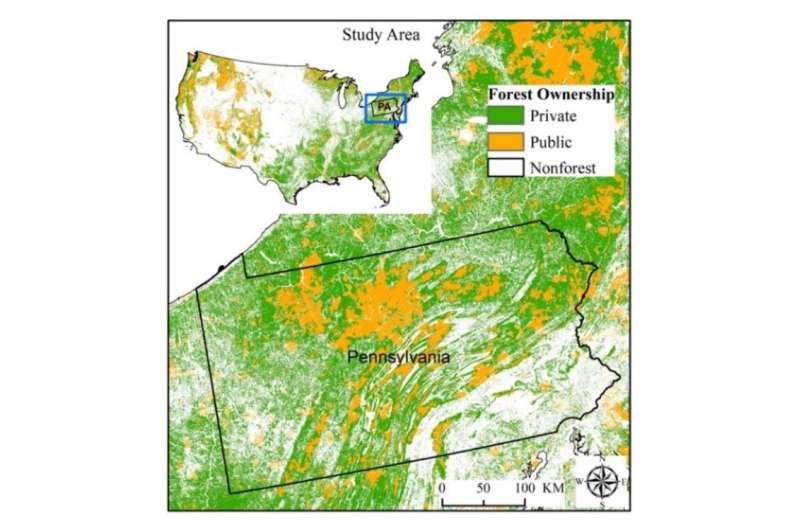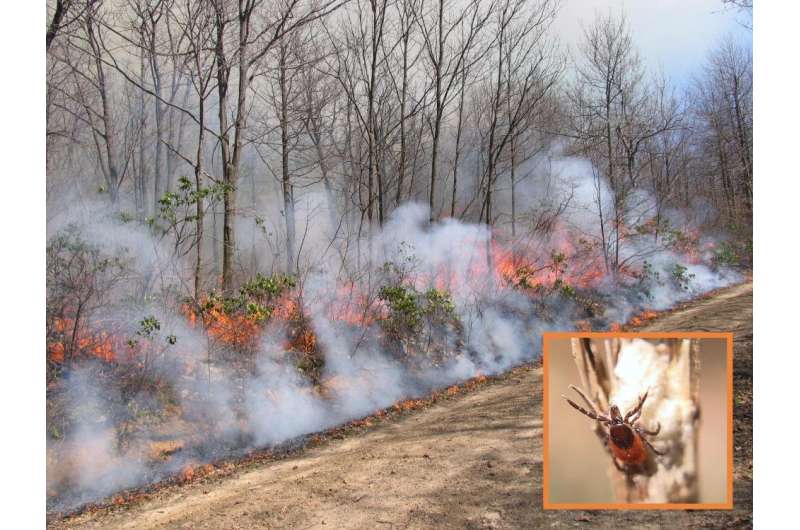Private forest landowners in Pennsylvania want to use controlled fire to manage their woods

Managers of public forests in Pennsylvania have been using controlled burns to manage state-owned tracts to promote tree species such as oak, reduce the growth of invasive plant species and even reduce tick populations, for more than a decade.
Now a study by Penn State researchers indicates that owners of private forest land in the state would like to use prescribed fire to manage their woods, too. The research is published in the journal Forest Policy and Economics.
The research also revealed that many private forest landowners are willing to pay to use controlled fire as a management tool, said researcher Jesse Kreye, assistant research professor of fire and natural resources management in the College of Agricultural Sciences.
Prescribed burning is important for the ecological health of fire-dependent forests, noted Kreye, who has been involved in private forestland controlled burning programs in the South and the West. However, he noted, there is little economic research examining landowner preferences for living with fire in the modern world.
“We know a lot about the ecological role of fire in our forest landscapes and how prescribed burning can be used to achieve beneficial outcomes,” he said. “But without understanding the human dimensions aspect, we can’t fully evaluate its potential. This research was aimed at understanding the value of reintroducing fire into the private forest landscape.”
The study, which was spearheaded by Arun Regmi, doctoral degree candidate in the Department of Ecosystem Science and Management, was a collaboration between Kreye and Melissa Kreye, assistant professor of forest resource management, who is also in the same department.
“My background and expertise are in the physical and ecological aspects of wildland fire, while Melissa’s are in natural resource policy, economics and social science,” said Jesse Kreye. “Interdisciplinary collaborations like these allow us to go beyond the ecological science toward a better understanding of how that science might actually be applied.”

Compared to southeastern and western regions of the United States, there is still very little prescribed fire applied to private lands in the Northeast, the researchers explained. They suggest that landowner interest in prescribed fire in this region previously had not been explored and could provide insights into how society may want to live with fire in the future. In several states, such as Florida, hundreds of thousands of acres are burned in a controlled way each year to manage private forest land.
“Forest landowners in Pennsylvania could have that option, too,” Jesse Kreye said.
Fire was used historically in Pennsylvania, the researchers point out, and the state’s forests have changed a lot over the last century because of a lack of fire. Because there was considerable interest in bringing fire back to help restore the landscape, the General Assembly in 2009 passed legislation called the Prescribed Burning Practices Act.
The law changed liability statutes and essentially gave land managers in the state who observe a suite of specified precautions the ability to use prescribed fire as a forest-management tool. This has since resulted in increased burning, but mostly on public lands. For example, in 2021 a total of 21,901 acres of public lands were prescribed burned by state agencies, whereas only 476 acres of private forests were burned.
“But even though agencies such as the Pennsylvania Department of Conservation and Natural Resources and the Game Commission have been burning on their properties over the last 14 years, private landowners have largely been unable to use the tool,” Jesse Kreye said. “And there are still a lot of people in Pennsylvania who aren’t aware of why they should be using controlled fire and what benefits it provides.”
About 16.9 million acres (58%) of the state is covered by forestland, of which 70% are privately owned. To assess private forest landowners’ willingness to pay for various prescribed fire programs in Pennsylvania, the researchers mailed a carefully constructed survey comprised of 63 questions to 551 private forest landowners in Pennsylvania.

The questions asked about land ownership and management objectives, landowner demographics, knowledge about prescribed fire, perceived risk, and trust in trained controlled burn personnel. Survey responses were collected from 243 landowners, resulting in a 44% response rate. Most respondents were classified as having limited experience with prescribed fire, but many also had low-risk perceptions about prescribed fire and high trust in prescribed fire implementors, such as burn bosses.
In the findings recently published in Forest Policy and Economics, the researchers reported that most forest landowners surveyed (66%) elected to enroll in at least one of 16 proposed controlled-burn programs and almost a quarter of landowners were willing to pay up to $200 per acre. Analyzing survey responses, the researchers determined that the value of prescribed fire to Pennsylvania across all private forest lands was estimated to range from $11 to $19 per acre.
Overall, respondents preferred programs that helped maintain ecosystem health and biodiversity, and offered cost-share, reduced liability and access to burn bosses. Demographic characteristics—such as income level, age and involvement in assistance programs—were important predictors of enrollment in prescribed fire programs.
Forest owners in Pennsylvania see prescribed fire as potentially helping them meet priority management objectives and supporting cultural values about forest stewardship, Melissa Kreye suggested.
“Technical and financial assistance for forest owners will be important for expanding the use of prescribed fire in Pennsylvania,” she said. “A better understanding of the economic value of prescribed fire, for meeting ecosystem health and resilience objectives, could be useful for informing policies that seek to restore fire adapted forest ecosystems in Pennsylvania and the Northeast.”
More information:
Arun Regmi et al, Forest landowner demand for prescribed fire as an ecological management tool in Pennsylvania, USA, Forest Policy and Economics (2022). DOI: 10.1016/j.forpol.2022.102902
Citation:
Private forest landowners in Pennsylvania want to use controlled fire to manage their woods (2023, February 17)
retrieved 17 February 2023
from https://phys.org/news/2023-02-private-forest-landowners-pennsylvania-woods.html
This document is subject to copyright. Apart from any fair dealing for the purpose of private study or research, no
part may be reproduced without the written permission. The content is provided for information purposes only.
For all the latest Science News Click Here
For the latest news and updates, follow us on Google News.

